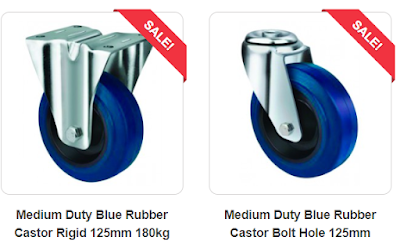Beyond Rotation: Strategic Factors For Heavy-duty Castor Decision-Making
Heavy-duty
castors, the workhorses of industrial mobility, shoulder the responsibility of
moving substantial loads with silent strength. Selecting the right castors for
your specific application is paramount for optimal performance, safety, and
longevity. The selection of these robust wheel assemblies goes beyond mere
compatibility; it requires a nuanced understanding of the specific demands and
conditions of the environment in which they will operate. From load capacity to
floor conditions, the journey of choosing heavy-duty castors in Melbourne
is a crucial step in ensuring the wheels of progress roll smoothly.
The multifaceted factors that should be carefully considered when choosing heavy-duty castors in Adelaide, ensuring a seamless and efficient operation across diverse industrial landscapes.
Load Capacity
The foundation of castor selection lies in understanding the load capacity requirements. Assess the maximum weight the castors will bear, factoring in variations in load distribution. Choose heavy-duty castors with load capacities that comfortably exceed the heaviest loads they will encounter, preventing premature wear and ensuring long-term durability.
Floor Conditions
The nature of the floor surface greatly influences castor performance. Consider the floor conditions where the heavy-duty casters will operate. Different wheel materials are suited for various surfaces — polyurethane or rubber wheels for smooth floors, steel wheels for rugged terrains, and non-marking wheels for delicate surfaces. Matching the wheel material to the floor conditions enhances both traction and durability.
Swivel vs. Fixed Castors
Determine the manoeuvrability requirements of your equipment. Swivel castors provide 360-degree rotation, offering enhanced agility, while fixed castors move only in a straight line. A combination of swivel and fixed castors may be ideal for achieving both controlled movement and stability.
Brake Mechanisms
Brakes are integral for controlling the movement and securing the load in place. Consider the type of braking mechanism needed for your application — total lock brakes that immobilize both swivelling and wheel rotation, directional lock brakes that control the direction of travel, or standard brakes for straightforward locking.
Wheel Diameter and Width
The size of the castor wheels directly impacts their load-bearing capacity and manoeuvrability. Larger wheels distribute weight more effectively and roll more smoothly over uneven surfaces. Consider the available space and the mobility requirements when selecting the diameter and width of the caster wheels.
Material of Construction
The material used in constructing heavy-duty casters determines their strength, durability, and resistance to environmental factors. Common materials include steel for robust applications, nylon for chemical resistance, and stainless steel for corrosion resistance. Choose materials that align with the demands of your specific industry and operating environment.
Temperature Resistance
Consider the operating temperature of the environment where the heavy-duty castors will be used. Some industries, such as manufacturing or food processing, may require castors with high-temperature resistance to withstand heat generated during operations. Choose castors designed to perform reliably in the temperature range of your application.
Environmental Factors
Assess the environmental conditions that heavy-duty castors will face. For outdoor applications, consider castors with corrosion-resistant materials. In environments where cleanliness is crucial, opt for castors that are easy to clean and resistant to contaminants.
Maintenance Requirements
Evaluate the maintenance needs of the heavy-duty castors. Some castors may require more frequent inspections and lubrication than others. Choose castors that align with your maintenance schedule and capabilities to ensure consistent performance and longevity.
Compatibility with Equipment
Ensure that the selected heavy-duty castors in Melbourne is compatible with the equipment they will support. Consider factors such as mounting options (top plate, bolt hole, stem), dimensions, and overall design to guarantee a seamless integration that maximizes functionality.
In
the labyrinth of industrial operations, the selection of heavy-duty castors is
a decision that reverberates across the efficiency and safety of processes.
Each factor, from load capacity to environmental considerations, contributes to
the intricate tapestry of optimal castor performance. By carefully evaluating
these factors, industries can ensure that their heavy-duty castors not only
meet the demands of today but also roll seamlessly into a future of sustained
productivity and reliability. The journey of selecting heavy-duty castors is a
voyage of precision and foresight, where each decision propels industries
toward the smooth and steady progress they seek.



Comments
Post a Comment